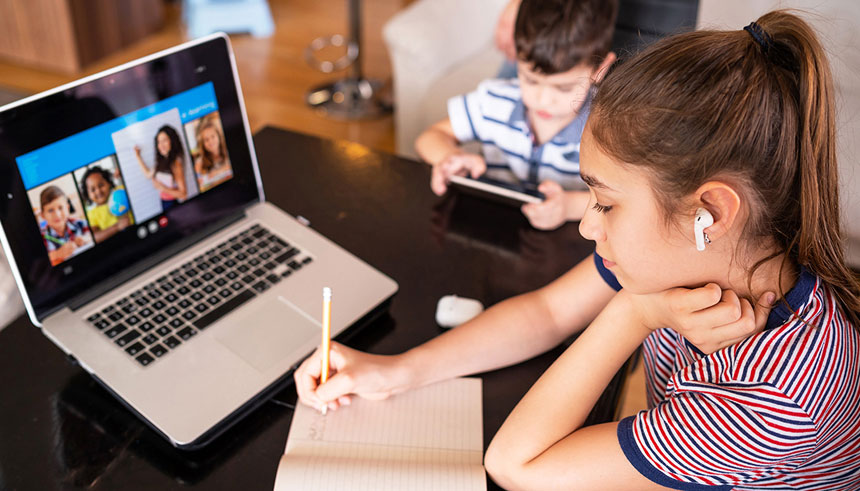JULY 8, 2020 | Reach Further
For more articles and related content, visit East West Bank’s digital business publication, Reach Further.

Team Tutors, a tutoring service for students in kindergarten up to 12th grade, has seen an uptick in tutoring demand since the start of the pandemic. (Photo credit): Gettyimages.com/valentinrussanov
How Team Tutors helps students succeed academically from home
The widespread coronavirus has forced schools around the world to close classrooms early, throwing a wrench in the educational trajectory for teachers and students. According to the World Economic Forum, more than 1.2 billion children in 186 countries have been affected by school closures caused by the pandemic. Many have pivoted to remote learning and online courses, often taught by teachers who have had to quickly shift their entire curriculum and teaching materials to a digital platform.
“It’s been a challenge for both me and the students,” says Sydnie Ho, a Los Angeles Unified School District elementary school teacher. “It’s impossible to tend to students’ needs when there are technological disparities, and it’s hard because I can’t be there to support them. Many of my students don’t have adequate access to internet services, or even devices that would allow them to be present without glitches during the online class, which is primarily through Zoom.” Ho adds that most of her time is spent showing students and parents alike how to transition to the new digital platforms and access learning materials. The issue is often exacerbated when the parents do not speak English.
New research estimates that by September, most students would have fallen behind by many months, with some students even losing the equivalent of a full school year’s worth of academic gains. Parents who have been quarantining in the house with their children have struggled to engage with them academically and have turned to tutoring services, mom blogs and even social media influencers to find creative and mentally stimulating ways to keep their children active.
“I think that every school, every teacher and every student has probably tried their best in moving quickly to online learning, but some students haven’t been able to transition very successfully, especially the younger ones,” says Nathalie Kunin, founder and CEO of Team Tutors, a tutoring service for students in kindergarten up to 12th grade.

“Having invested in this technology and platform allowed us to be the leaders when COVID-19 struck, because many companies weren’t able to offer their courses virtually right away.”
-Nathalie Kunin
(Photo credit): Gettyimages.com/MEDITERRANEAN
Test prep for the SAT and ACT, to more niche tests like the ISEE that’s required to enroll in private schools, have all seen a jump. “We had already done the lion’s share of the work; our materials were all set up for virtual test prep when the virus hit, and all of the materials are accessible online,” says Kunin. “I don’t think that’s going to change for us, and I think this method of learning will only get more popular.”
Pivoting with the PPP loan
When COVID-19 initially struck, Kunin and her team of tutors also had to find ways to pivot quickly and move everything online. “Everything had to move fast, and we did some really targeted retraining for our tutors,” says Kunin. “The part that was really difficult was scheduling all of the new and different time slots for virtual tutoring, because now more children were available at different times and most of these children had distance learning taking place at different times with their schools, too.”
Given the abrupt change, Team Tutors looked at the most effective ways to fill in any gaps that students might face during their time outside of school. “We actually made a lot of changes logistically, invested heavily in virtual platforms, and learned about the changing financial landscapes for some of our clients, as well,” says Kunin.
She wanted to retain her team and saw a possibility. “We decided to take a PPP (Paycheck Protection Program) loan, which enabled us to keep things under control and focus on the areas that could help families and students the most without having to worry too much about the payroll side,” Kunin states.
(Photo credit): Gettyimages.com/erhui1979
When she initially applied for the PPP loan, however, Kunin never heard back from her bank. “It’s like our application vanished into cyber space. We didn’t even get a confirmation number, we didn’t receive any updates and we didn’t get to speak to a live person,” she shares.
When the federal government issued a second round of PPP funding, Kunin decided to work with Agnes Lew, senior vice president and director of private banking at East West Bank. “She came in right away, and we worked with her team all weekend long, and by Monday afternoon, we received our PPP loan,” says Kunin. “Thanks to East West Bank and the PPP loan, we didn’t have to furlough anyone, we didn’t have to let anyone go, no one had to take a reduction in salary, and all the tutors that wanted to stay with us were able to do so.”
Advice for parents with children who may be struggling with remote learning
Being highly observant of your child’s behavior is key in identifying red flags, especially for those in their early years. “The early foundational years from kindergarten through sixth grade is a significant piece of what sets students up for success,” says Kunin. To best support a positive learning environment, Kunin suggests looking at these three pillars:
- Social belonging, where a student feels a part of the school community and engages regularly with peers and teachers alike.
- Academic rigor, where a student feels like he or she can demonstrate critical thinking and feel like they’re being challenged with engaging courses.
- Emotional stability, where a student feels good about learning and is generally happy to be mentally stimulated.
One of the key things that Kunin has seen among children with the onset of COVID-19 is the increase in anxiety levels. “Even before the pandemic, students face a lot of pressure in a competitive world,” she says. “Everyone’s working hard to be successful, and I think that many children today are struggling with anxiety over schoolwork.”
For many children who are unable to confide in someone, they simply shut down. “If you notice your child’s anxiety levels growing because they’re comparing themselves to other children at school or because they’re struggling with their studies, reach out to a specialist,” says Kunin. “Anxiety and confidence are like two sides of a scale. When anxiety is up, confidence is down, and when anxiety is low, confidence is high. And one of the key indicators of a successful student and a happy learner is their confidence.”


